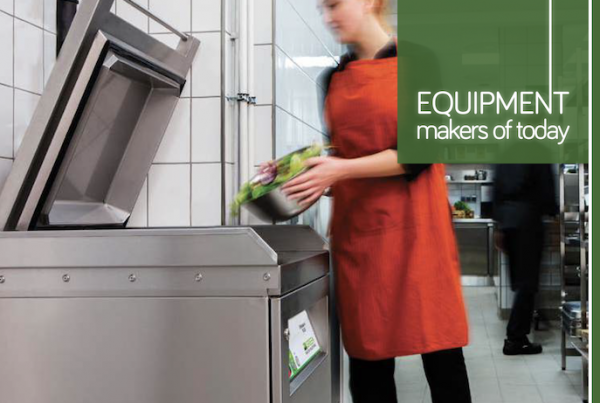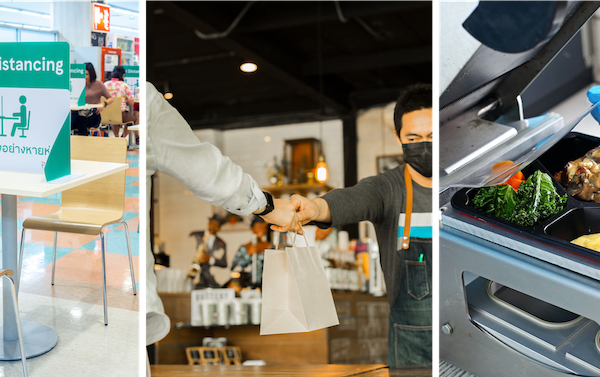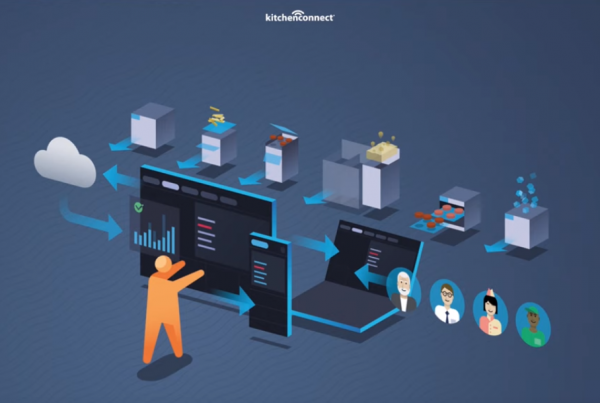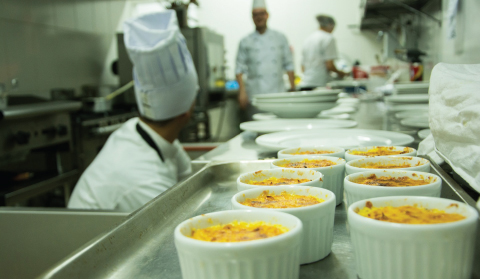
We had much to learn about the Japanese food culture and Japanese restaurants, especially when it comes to their flair for using unique equipment for an efficient meal preparation process. That only tells us that when operating a restaurant, it is critical to ensure that all operating parameters, processes, and procedures are optimally designed and aligned because efficiency, after all, is the key of a restaurant’s success.
And that brings us to the question – what equipment and technology platforms are you using? Technology and equipment must be part of the integrated solution for it to truly have the most impact on your commercial equipment, so it is important to review how and what sort of technology is being used to see where more is needed and where isn’t.
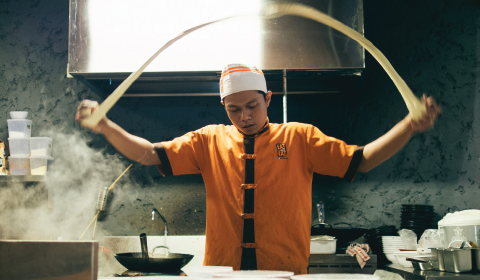
OPERATIONAL EFFICIENCY
One problem any restaurant operator has to deal with is labour deployment. Not only is labour turnover in the F&B industry becoming a critical issue, currently either the largest or second largest line item cost in many restaurant budgets perceiving the fact that the cost of employees is on a constant rise. In fact, many countries are already establishing instituted legislations that would set the minimum wage of labour, much recently in Malaysia too.
While technology may not fully replace human labour, bringing operational efficiency to a restaurant workforce in other ways may make things much better for the restaurant business. The key to that is having the right labour in the right place at the right time to drive sales. The best way to manage labour is by applying a work content and activitybased process and to let the financial metric be influenced by the output.
In other words, if you do the right thing for your employees by simplifying what they do and taking bottlenecks and roadblocks out of the way, they will deliver the right hospitality, which brings higher sales and profits, resulting in better unit economics that drives brand growth. In other words, driving efficiency is the only way to have the right unitm economics that can fuel profitable hospitality that lead to brand growth.
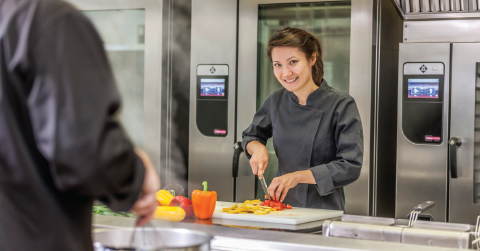
So, how does using the right equipment improve operational efficiency in your restaurant?
1. Multifunctional cooking equipment reduces “labour stress”.
Multifunctional cooking equipment can help a lot to work efficiently in professional kitchens. With automatic cooking programmes, automatic cleaning systems, and modern operation systems, commercial kitchen equipment are definitely easier and faster for kitchen staffs to use. At the same time, as today’s restaurants are getting smaller, the need for equipment that’s smarter, smaller, and easier to operate is becoming prevalent. With this shift, foodservice equipment that reduces the dependency on labour, makes training much easy and improves efficiency is a must-have, along with technology that is simple.
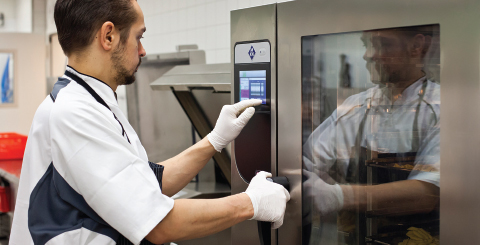
One commercial kitchen equipment among many that appear to facilitate this is the FlexiCombi MagicPilot, a combi steamer by MKN. Considering the fact that people in daily life do not have a problem using their smartphones naturally and intuitively, the Touch & Slide operating concept of the MKN combi steamer FlexiCombi MagicPilot strives to prove that combi ovens are just as simple to use.
The FlexiComb MagicPilot facilitates professional cooking with its touch screen ability, individually adapted to the specific requirements of professional chefs and provide considerable assistance for untrained personnel in a commercial kitchen. With integrated information steps, favourites function on the start display, and video clips with operating instructions shown directly by the appliance, the MagicPilot offers remarkable user comfort, improving efficiency in the back-ofhouse operations of a commercial kitchen.
Additionally, the FlexiCombi is a crosswise combi. Trays and GN containers can be lifted easily and safely. Without having to keep changing the position of hands, kitchen staffs can also have a brilliant image representation of food preparation with full viewing angle from all sides, at all times.
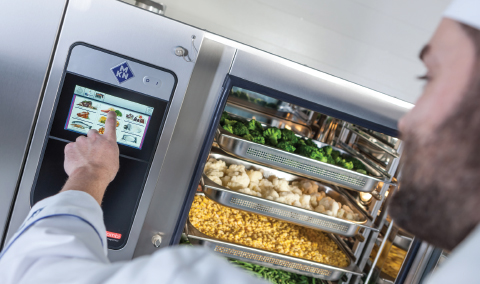
The general overview of the features of FlexiCombi include:
• Touch & Slide operation similar to a modern smartphone
• Smart capacity concept
• Easy and safe crosswise combi function
• Automatic quantity detection which maintains food quality
• Select cooking programmes using a scan
• Virtual chef inclusive
• Starts the most frequently used cooking recipes asfavourites immediately on the start display
• Advice and assistance providing information steps to the user
• Water and energy consumption display shown after each cooking process
• No contact with chemicals as detergent and rinse agent are in one sealed cartridge
Commercial kitchen equipment that are able to handleseveral cooking methods and offer multiple functions forpreparing a variety of foods are a definite life-saver forrestaurants that want to overcome operational issues inthe kitchen back-of-house. This will help the kitchen runmore smoothly and produce higher-quality food, causing
lesser stress employees and result in a more relaxed andpersonable staff. And it only looks like MKN is committedto making this happen. For more information on MKN’s
FlexiCombi, you may contact:
MASCHINENFABRIK KURT NEUBAUER GMBH & CO. KG (MKN)
www.mkn.com

2. Match equipment to production level.
There are certainly many benefits to back-of-house automation. Some of the main considerations in efficiently operating the back-of-house of a restaurant include production, food cost analysis, scheduling, staffing, training, the involvement and follow-up of management, as well as employee recognition. Among all, one serious consideration for a commercial kitchen when it comes to automation is production.
Production, however, is grippled by two common problems – productivity and efficiency in the kitchen. In a fast-paced food-chain environment, the two problems, singularly or combined, can prolong the time taken to serve a dish. Most commercial kitchens will prepare hundreds of dishes a day, so their equipment must be able to quickly prepare meals.
At this point, it is worth noting that the size of the kitchen and its equipment should be designed according to the forecasted sales for the restaurant and the menu. The menu dictates the equipment needed as well as the experience level of the cooks and the kitchen should be set up according to customer preferences and most frequent order list. If a restaurant is serving more broiled or sautéed items, for instance, the size of the broiler and sauté should be larger and able to cope with the demand of servings.
The Merrychef eikon® e2s is one that considers this need. The oven prepares fresh, hot food on demand where space is at a premium while accommodating various ways of cooking such as toasting, grilling, baking, and regenerating a wide range of fresh or frozen foods. This includes the ease of cooking sandwiches, pastries, pizza, fish, vegetables and meat. Such flexibility supports business growth by allowing rapid menu changes and additional food offerings from one small unit.
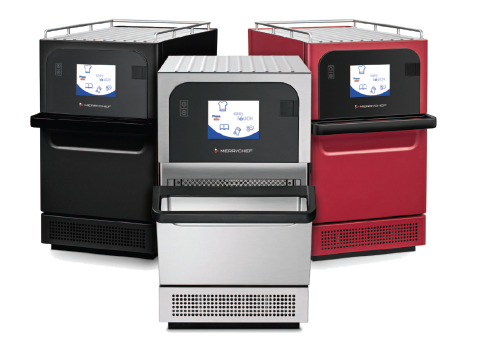
The rapid cooking feature of the oven combines three heat technologies – tuned impingement, microwave, and convection, which makes it 20 times faster than cooking food in a typical convection oven. The other benefits of using Merrychef eikon® e2s include:
• User-friendly functions: Icon-driven touchscreen combined with class leading cleanability offers easy operation, minimal training, and increased efficiency.
• Flexibility: The versatile high speed oven adapts to the evolving needs of food service businesses through menu expansion on a single platform, thus thus futureproofing the business.
• Productivity: Ground-breaking cavity to footprint ratio. The eikon® e2s enables high throughput at premium quality, maximising return on investment for food service businesses.
Take for example, the Singapore Chilli Crab – this iconic dish cooked in flavourful sweet and salty, chili-hot tomato sauce is enjoyed by the locals in Singapore and often uses a wok for a meticulous and careful cooking process. But with Merrychef eikon® e2s, the Singapore Chilli Crab can be cooked in just three minutes. Pour gravy into the tray of crab; insert the tray into the Merrychef® eikon® e2s oven; set the temperature at 260 deg alongside fan speed at 10 percent; microwave at 100 percent and cook it for 2 min – and there you have, an effortlessly cooked Singapore Chilli Crab dish.
For more information on how Merrychef eikon® e2s can be used by chefs who are very innovative and by restaurants that wish to constantly create new recipes to test customer preferences, you may contact:
WELBILT ASIA
www.merrychef.com
WORKFLOW EFFICIENCY
Here’s one vital question for every restaurant operator – do you find it difficult to prepare your products during a busy period? This is a question that considers whether or not all the stations of your restaurant work together. Customer experience becomes less efficient when one area of the commercial kitchen runs well while another does not, which poses direct risk to the likelihood of customers returning. To prevent such stances, all storage areas and work surfaces required to produce an item in the meal preparation process should be located closely to one another, as shown in the figure below. Included in the list are work counters, fryers, grills, ovens, freezers, refrigerated storage, dry storage, and storage for plates and glassware.
“I entered a restaurant not too long ago to find frozen chicken heaped in a pile in the filthy three-bay sink, with dirty dishes and utensils surrounding the frozen raw poultry.”
– Confession of a health inspector

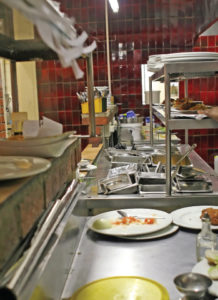 Without having to compromise on the authenticity of a specific recipe, certain processes could be combined if not reduced, to increase the efficiency of workflow and eliminate chances of cross-contamination. For instance, pre-sanitised vegetables could very well replace the need to sanitise the greens in-house. This technique also reduces the chances of over dosage of chlorine based sanitiser tablets used in most conventional produce washing processes. Creating working zones ensures seamless workflow, reduces chaos, and enhances cross-functional communication within the kitchen. Zones within the kitchen do not necessarily need to be visibly demarcated but they shouldn’t overlap with processes that could result in cross-contamination.
Without having to compromise on the authenticity of a specific recipe, certain processes could be combined if not reduced, to increase the efficiency of workflow and eliminate chances of cross-contamination. For instance, pre-sanitised vegetables could very well replace the need to sanitise the greens in-house. This technique also reduces the chances of over dosage of chlorine based sanitiser tablets used in most conventional produce washing processes. Creating working zones ensures seamless workflow, reduces chaos, and enhances cross-functional communication within the kitchen. Zones within the kitchen do not necessarily need to be visibly demarcated but they shouldn’t overlap with processes that could result in cross-contamination.
In other words, the lesser the steps required for kitchen staffs to complete a task, the greater the efficiency of the team. Ergonomics has a huge role to play in this consideration, doesn’t matter how elaborate and wellequipped a commercial kitchen is. The likelihood of crosscontamination is reduced when the simple principles of ergonomics are applied in the designing process.
One example of this would be the use of under-counter chillers. Using the right undercounter chillers lessens the need to walk to the allocated walk-in refrigerators frequently while saving a lot of space. Being mindful of the heights of equipment hinders inefficiency in food preparation process and avoids risks in injuries among employees. After all, employee safety and mobility should be the paramount importance for any restaurant.
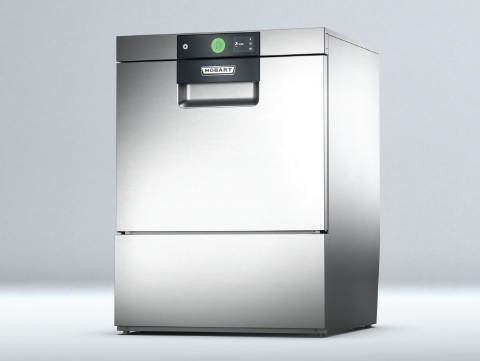
The new HOBART PREMAX generation of Undercounter Dishwashers and Glasswashers appear to be oneamong many that capture this concern in the practice of dishwashing. Because drying wet washware is laborious and time consuming, especially at the point of needing dishwashing crews, the latest HOBART PREMAX generation of Undercounter Glasswashers and Dishwashers aims to provide instantaneous drying results with its unique TOPDRY drying system.
TOP-DRY Drying ensures that dishes and glasses are ready for re-use immediately after washing, without any additional drying or polishing. Once the washing process is complete, the humid air is directed via starting a fan into a special hydro-thermal energy storage system and is then converted and reintroduced into the wash chamber as hot drying air. Moisture can no longer be deposited onto the wash ware, while tableware and glasses no longer need to be dried and polished by hand. Also, as the drying system uses humid air from the wash chamber and converts it into hot, dry air, there is no need for any additional energy consumption.
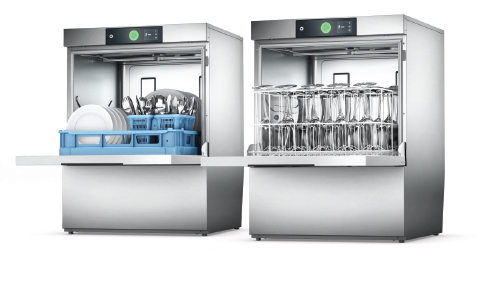
This saves the staff a lot of time and effort, particularly during the the peak hours, facilitating a standardised workflow in the kitchen. Consistency in processes is also ensured, from the back-of-house to the front. After all, the dishwashing crew’s labour and time can be used for much more productive tasks in the commercial kitchen.
Other features of the new HOBART PREMAX generation of Undercounter Dishwashers and Glasswashers include:
• VAPOSTOP² : The feature prevents steam from escaping not only during the washing and drying process but also when the dishwasher door is opened. This avoids discomfort for the guests sitting close to the bar and negative effects on the room climate.
• ECO programme: The intelligent PREMAX models work with waste steam, using only 1.0 l of fresh water per rinse cycle which reduces the water and detergent consumption by up to 60 percent.
• HOBART WASHSMART: The app provides comprehensive information on the status of the new PREMAX (and PROFI) glasswashers and dishwashers. The end customer can be well in advance informed of pending maintenance dates; can see the system information on chemicals consumption and running costs; receive failure messages; and easily monitor all hygiene and operational data.
Hobart believes that deploying the right dishwasher can bring several benefits. One of it, considering the size of operation, a suitable commercial dishwasher can effectively handle large amounts of dishes in a short time. This helps to increase the availability of ware, enabling faster table turnover, and facilitate a better workflow. Deploying the right dishwasher also increases the efficiency of manpower and overall kitchen space.
So, think through on how your dirty dishes can affect the workflow in your commercial kitchen, and how your dishwashing crew feel about it. For more information on the new HOBART PREMAX generation of Undercounter
Dishwashers and Glasswashers, you may contact:
HOBART
www.hobart-export.com
EFFICIENCY: CONFESSIONS FROM
THE F&B WORLD
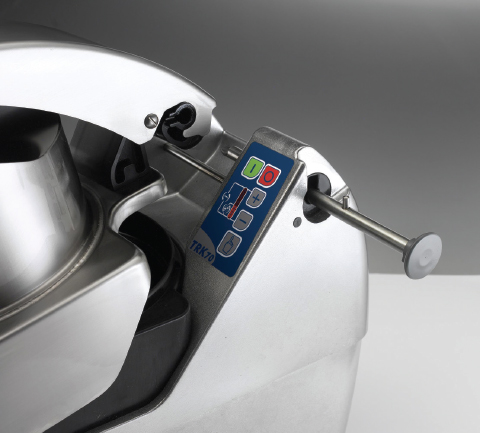
2. Prepare foods, faster.
We know that freshness of meal is vital to many customers as more people prefer to have food prepared following the order. But there are certain preparations that should take place ahead of time to increase efficiency for the kitchen. A good example would be meat wraps. Kitchen staffs can have the meat cooked beforehand and prepare it with fresh wrap and other ingredients when the orders start coming in. They can have the potatoes peeled, and vegetables cut up prior to the order.
Production equipment such as mechanical peelers, choppers, mixers, vegetable slicing machine, and meat preparation machine can reduce the amount of time spent doing food preparation tasks. Using the right vegetable slicing machine, for instance, can be greatly beneficial to restaurants, catering, cruise ships, offshore oil rigs, army, associations, institutions and hospitals. Not only that, it would be able to maintain consistency especially when there is a large amount of food that needs to be cut to specific sizes. And it looks like TRK Combined Cutter-Slicers by Electrolux Professional is doing a pretty good job on that.
TRK Combined Cutter-Slicers is a 3 in 1 equipment combining vegetable slicer, food processor and emulsifier. The equipment can be easily changed from a vegetable slicer to a food processor or emulsifier in a matter of seconds without the aid of any tools, making the preparation of an entire menu from hors d’oeuvres to desserts without having to waste time changing equipment for a different requirement.
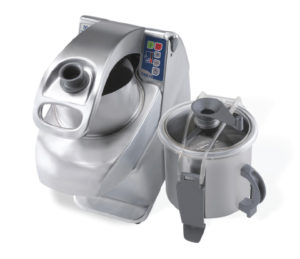
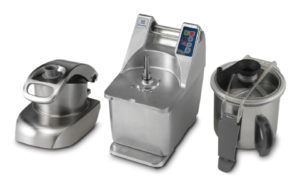
The main features of the equipment include:
• Cutter equipped with transparent lid and scraper function with maximum speed up to 3700 rpm. There is no need to stop the machine for scraping during operations which actually ensures a better homogenisation.
• Stainless steel bowl with high chimney that brings improved “real” liquid capacity.
• Wide range of stainless discus (205mm diameter) for more than 80 different cuts including a unique and exclusive “S” shaped blades for greater efficiency and versatility in cutting.
• User-friendly functions thanks to the Incly System. The equipment is able to incline motor base by 20 degrees for better ejection of vegetables and makes loading and unloading operations quick and easy.After all, the main objective of a food processing equipment is to increase productivity and efficiency.
For more information on TRK Combined Cutter-Slicers, you may contact:
ELECTROLUX SEA PTE LTD
professional.electrolux.com.sg

The key to selecting the right tools and equipment is to match the parameters of their use to expected volume of business. Let’s consider a mixer, for example. If you are purchasing a large mixer for a fairly moderate volume of business, the efforts of maintaining and cleaning the machine after using it will not warrant the extra expense of purchasing the equipment. A small mixer, on the other hand, will reduce efficiency as you will be unable to mix the quantities needed in a single batch. Find the balance and you will observe more efficiency in your food preparation process.
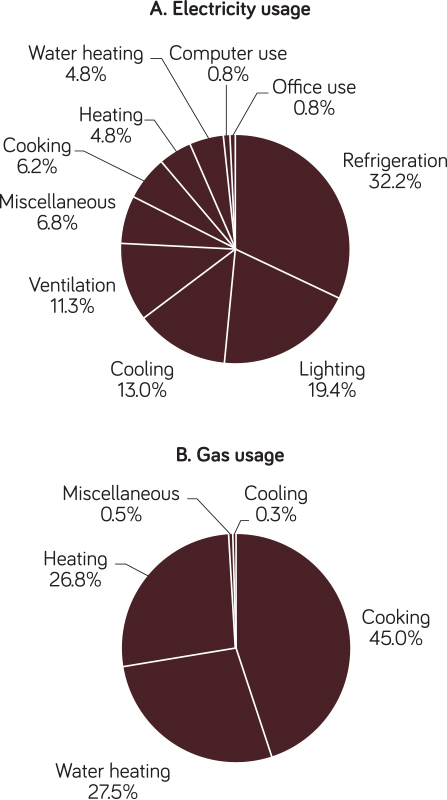 ENERGY EFFICIENCY
ENERGY EFFICIENCY
Most commercial kitchens such as quick-service restaurants, casual dining restaurants, restaurant chains, cafes, and hotels are undoubtedly intense energy users. These establishments consume as much as three times more energy per square foot than most other types of commercial buildings.
Food preparation is one of the largest culprits in this issue. In fact, food preparation makes up the largest percentage of a restaurant’s energy bill at about 30 percent, with refrigeration costs running somewhere around 13-18 percent depending on who you ask. Directly impacting a commercial kitchen’s energy bill, another research indicates that kitchen equipment such as refrigeration, water heaters, and HVAC systems represent nearly 60 percent of total energy use.
Truth is, these equipment can be excellent targets for energy savings when given much attention to. Contrary to public perception, making simple operational changes can actually reduce energy use by as much as 10 to 30 percent while keeping the costs low. There are also non-energy benefits to doing this, such as improved operating performance and increased kitchen staff comfort. That’s why using the right equipment for food preparation greatly matters in ensuring energy efficiency in your restaurant.
So, how does using the right equipment improve energy efficiency in your restaurant?
1. Keep warm food warm, keep cold food cold.
Time is the key essence in a commercial kitchen, especially in terms of preserving food. To keep warm food warm, make sure to check convection ovens, steamer doors and seals. A proper seal will prevent the heat from escaping. To keep cold food cold, be sure to inspect freezer doors for air leaks. Check for worn gaskets and door alignment. Make sure automatic door closers are closed correctly. This will help improve energy efficiency and prolong the life of the equipment.
Every commercial kitchen has refrigeration equipment such as refrigerators and freezers, but investing in the right one definitely makes a difference for a restaurant. Let’s take a look at Irinox Multifresh Blast Chiller for this case.
To keep cold food cold and save energy at the same time, we first need to understand process speed and process capacity, two elements that essentially determine how much energy is saved. In terms of process speed, the equipment consists of a unique feature known as the “Irinox Balance System”. The system focuses on 4 core component of the blast chiller to increase its efficiency and result quality. The 4 components include:
• Fan, designed with an ultra-efficient blade profiling enabling humidity management system, speed variation, noise reduction and energy saving because it is light.
• Condenser, designed with low notice level and maximum performance in ambient temperature.
• Compressor that bases on high efficiency, reliability, and low energy consumption.
• Evaporator, a custom design of Irinox with anti-corrosion cataphoresis coating and multiple injection system that enables string cold recovery.
All four components are built according to the golden ratio which enhances the product quality and machine efficiency. An undersized fan, for instance, will cause ice forming on evaporator and low refrigeration yield, while an oversized fan will cause longer chilling or freezing time and lower refrigeration yield as well.
The process capacity, on the other hand, enables precise control and communication with the “Irinox Balance System”, also known as its hardware. With both soft and hardware system working efficiently, a restaurant is able to achieve efficiency in terms of energy consumption, process time, refrigeration yield, and product quality.
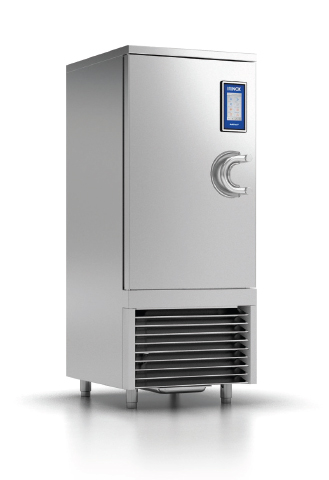 Having these two elements in sync with the production line will certainly increase the production cost and production volume efficiency. In case one is curious how it all works, Irinox Multifresh Blast Chiller saves the complication with its easy to follow SOPs.
Having these two elements in sync with the production line will certainly increase the production cost and production volume efficiency. In case one is curious how it all works, Irinox Multifresh Blast Chiller saves the complication with its easy to follow SOPs.
1. Identify whether or not the product weight is in line with the machine capacity.
2. Pre cool the chamber before use to achieve better product consistency and better process time.
3. Identify the correct chilling or freezing program. This is where quality of the product and efficiency of the process is affected).
4. Use the core probe anytime. This will avoid over processing which saves energy consumption, and induces accurate process time that enables efficient production planning.
5. Lastly, always remember to defrost the machine at the end of the day. This daily maintenance will be able to ensure the machine is always in top condition for use with a longer shelf life.
Investing in a good blast chiller or freezer comes with a certain cost. Yet, if the cost is able to save the cost of energy consumption, it’s probably worth considering. For more information on Irinox Multifresh Blast Chiller, you may contact:
IRINOX S. P. A
www.irinoxprofessional.com
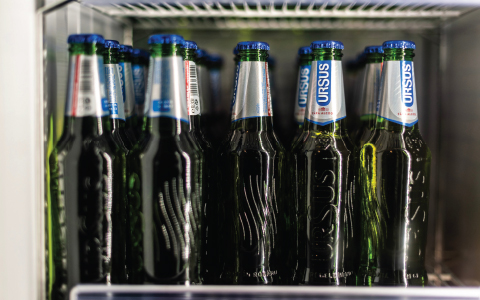
2. Buy energy efficient equipment.
Deemed highly efficient by the Foodservice Technology Center (FSTC) and the Consortium for Energy Efficiency (CEE), the Energy Star-labelled foodservice equipment is garnering attention from food service operators worldwide. Considering the fact that nearly a huge percent of the yearly budget of a food service establishment is spent on energy, switching to energy efficient commercial kitchen equipment can save a significant percentage on energy costs.
“The rule of thumb is: only use what you need, when you need it.”
– Confession of a kitchen engineering team lead.
According to the Association of Water & Energy Research Malaysia, there are three factors that contribute to high energy consumption:
• Electricity consumption of the equipment itself. The purchase of second hand equipment and non-energy efficient equipment is highly observed among some businesses in Malaysia, mainly because of low initial cost of such equipment. Once purchased, the operating cost begins to spike throughout usage period. Cooling, heating and rotating functions are direct contributors to the high energy consumption.
• The number of equipment used. In large set ups such as restaurants, using multiple equipment such as lights, mixers, ovens, motors, and commercial refrigerators in large quantities give huge impact to electricity consumption.
• The usage duration. Long usage hours such as in the F&B industry are directly proportionate to electricity or energy consumption.
By investing in energy efficient commercial kitchen equipment, water can be saved and energy consumption can be reduced. And it appears, Kristen Spanza, a food and beverage sector lead of Stantec is right about that. “Your business isn’t saving energy. Your business is making food, and making it well, and keeping the quality superior. So the question is how energy sustainability can promote that and contribute to that. And it’s amazing; there are tons of things you can do.”

“Having the right equipment will help to contribute to efficiency and alignment to the philosophy of having high quality food and experience in all of our restaurants.” – Confession of a restaurant owner and operator, Luis Daniel, Kenny Rogers Roasters (KRR) Malaysia.
The F&B sector is a tricky one: frozen items must stay frozen, refrigerated product shouldn’t get lukewarm, and cooking must be hot enough. In the juggle of making all of this happen, efficiency often gets lost. Despite how hard one tries to improve commercial kitchen efficiency, a faulty or wrong commercial cooking equipment can only slow the cooking process. And it looks like Kenny Rogers Roasters was able to not only relate to this problem, but also solve it using the right combi oven. To find out more on Luis’ experience in using the right equipment, scan the code below!







